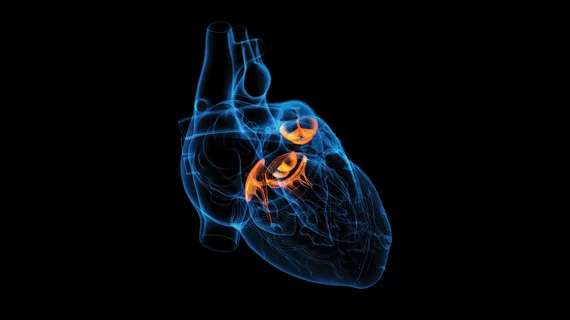The global market for transcatheter treatment of the mitral and aortic valves is expected to double over the next five years, according to a report from BCC Research. The industry analysis projects an increase from $4 billion in 2018 to $8 billion in 2023, at a compound annual growth rate of 14.8 percent.
Transcatheter mitral valve repair (TMVR) accounted for just 12 percent of transcatheter aortic or mitral procedures in 2017, according to the report, but is expected to grow faster over the next few years than the more established field of transcatheter aortic valve replacement (TAVR). BBC research predicts that, in 2023, TMVR will account for 22 percent of the segment while TAVR will claim the other 78 percent—down from 88 percent in 2017.
“The burden of chronic diseases such as arterial disease, hypertension, obesity/diabetes, and other heart-related disorders is rapidly increasing in both developed and developing nations and is fueling market growth,” the report states. “In addition to a large disease population, shorter recovery time, and shorter hospital stays, favorable outcomes with TAVR and TMVR and technological advancements are also driving the adoption of transcatheter heart valve devices.”
But market barriers exist, according to BCC Research analyst Ritu Thakur Dangi, BAMS, who authored the report. The high cost of heart valves, concerns over surveillance and long-term durability of artificial valves, reimbursement issues and regulatory approval processes could hamstring growth, she told CardiovascularBusiness.com in an email.
“Achieving statistically significant outcome from clinical trials and getting an approval for complex and challenging primary as well as secondary indications is the major challenge for now,” she wrote. “I think it should have a close watch over the next few years as most of the companies are struggling to get statistically significant data from ongoing clinical trials along with required positive clinical outcome.”
Here are three other notable takeaways from the report:
1. A few players dominate the space.
Though more companies are looking to break into the TAVR/TMVR space, Edwards Lifesciences (55 percent), Medtronic (29 percent) and Abbott (14 percent) shared about 98 percent of the market in 2017. And those device makers are taking steps to maintain that stranglehold.
“All of the market leaders have focused on merger and acquisition activities and have strengthened their market position through acquisitions, minority investments, and financing activities to be in the position to buy targeted early-stage companies,” the report states.
Abbott is well-positioned in the TMVR sector thanks in large part to its MitraClip device and the positive results from the COAPT trial (N Engl J Med 2018;379[24]:2307-18). Previously approved only for degenerative mitral regurgitation, MitraClip's label was expanded in early April to include patients with secondary mitral regurgitation. William Abraham, MD, chair of excellence in cardiovascular medicine at Ohio State University and a COAPT co-author, estimates there are 300,000 to 500,000 COAPT-like patients in the U.S.
“Abbott’s MitraClip alone is making sales of nearly $500-600 million and expected to reach around $2 billion sales by 2025,” Dangi wrote in the email. “Edwards Lifesciences is the close competitor and struggling to generate [a] few million [in] sales by the end of this year. However, device development and plans seem to be promising and Edwards is expected to make nearly $600-$700 million sales by 2025.”
2. TAVR’s progression to a lower-risk population will drive some of its growth.
TAVR began as an alternative therapy for patients deemed at prohibitive risk for open surgery and has now been studied in patients at high, intermediate and low surgical risk. If the procedure continues to demonstrate efficacy in lower-risk populations—as it did in two trials presented at ACC.19—there are huge implications for the TAVR market overall, given many patients’ preference for the less invasive option. Though Dangi wrote the BBC Research report before ACC.19, she says she factored these risk-group considerations into her market analysis. The contributions of low- and intermediate-risk patients to the market are “way low for now,” she notes, but are expected to comprise more than 25 percent in the next six to eight years.
3. The U.S. will remain the top provider of transcatheter heart valve treatments.
The U.S. will continue to drive more than half of the market, reaching $4.8 billion of the projected $8 billion by 2023, according to BCC Research. Europe is expected to be the second-largest market, while Asia will witness the fastest growth due to its expanding aging population, growing acceptance of transcatheter procedures, increased availability and affordability of treatment and advanced technology products and solutions.

